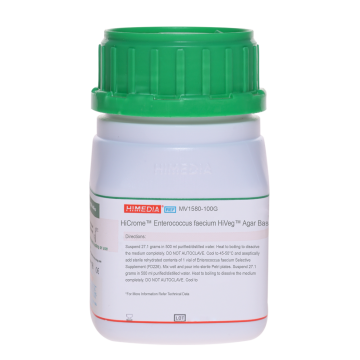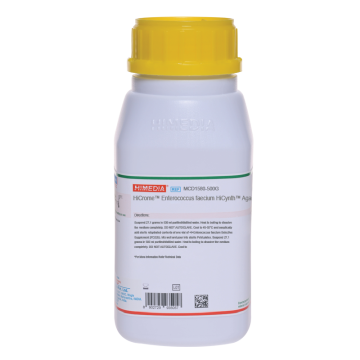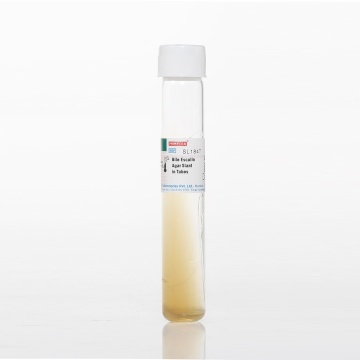 Your enquiry has been submitted
Your enquiry has been submitted
HiCrome™ Enterococcus faecium Agar Base
Intended use
Recommended for the chromogenic identification of Enterococcus faecium from faeces, sewage and water supplies.
Composition**
| Ingredients | g / L |
|---|---|
| Peptone, special | 23.000 |
| Corn starch | 1.000 |
| Sodium chloride | 5.000 |
| Arabinose | 10.000 |
| Phenol red | 0.100 |
| Chromogenic substrate | 0.100 |
| Agar | 15.000 |
Final pH ( at 25°C) 7.8±0.2
**Formula adjusted, standardized to suit performance parameters
Directions
Suspend 27.1 grams in 500 ml purified / distilled water. Heat to boiling to dissolve the medium completely. DO NOT AUTOCLAVE. Cool to 45-50°C and aseptically add sterile rehydrated contents of 1 vial of AC Selective Supplement (FD226). Mix well and pour into sterile Petri plates.
Principle And Interpretation
HiCrome™ Enterococcus faecium Agar Base is recommended for the chromogenic detection of Enterococcus faecium from urine, faeces, soil, food, water, plants and animals. E.faecium is commonly found in the gastrointestinal tracts of humans (1). The resistance exhibited by Enterococcus species to various antimicrobials has led them to being a major cause of human infections including nosocomial infections (2). E.faecalis causes 80-90% of infection while E.faecium causes the majority of the remainder (3). The use of selective media for the isolation of Enterococci has been previously reviewed, including those containing chromogenic substrates (4) and media containing cephalexin-aztreonam supplements. Enterococcus species possess the enzyme ß-glucosidase, which specifically cleaves the chromogenic substrate to produce blue coloured colonies. E.faecium ferment arabinose; and cleaves the chromogenic substrate present in the media to produce green coloured colonies along with yellow colouration to the medium. E.faecalis does not ferment arabinose and therefore retains the blue colour. Peptone special serves as a source of carbon, nitrogen and essential growth nutrients. Corn starch neutralizes the toxic metabolites while sodium chloride maintains the osmotic equilibrium. Phenol red serves as a pH indicator with arabinose being the fermentable carbohydrate.
Type of specimen
Clinical samples : urine, faeces, etc.; Food samples ; Water samples.
Specimen Collection and Handling
For clinical samples follow appropriate techniques for handling specimens as per established guidelines (5,6). For food samples, follow appropriate techniques for sample collection and processing as per guidelines (7). For water samples, follow appropriate techniques for sample collection, processing as per guidelines and local standards (8). After use, contaminated materials must be sterilized by autoclaving before discarding.
Warning and Precaution
In Vitro diagnostic use. For professional use only. Read the label before opening the container. Wear protective gloves/protective clothing/eye protection/face protection. Follow good microbiological lab practices while handling specimens and culture. Standard precautions as per established guidelines should be followed while handling specimens. Safety guidelines may be referred in individual safety data sheets.
Limitations
- Individual organisms differ in their growth requirement and may show variable growth patterns on the medium.
- Each lot of the medium has been tested for the organisms specified on the COA. It is recommended to users to validate the medium for any specific microorganism other than mentioned in the COA based on the user’s unique requirement.
- Slight colour variations may be observed depending on the utilization of the substrate by the organism.
Performance and Evaluation
Performance of the medium is expected when used as per the direction on the label within the expiry period when stored at recommended temperature.
Quality Control
Appearance Light yellow to pinkish beige homogeneous free flowing powder
Gelling Firm, comparable with 1.5% Agar gel
Colour and Clarity of prepared medium Red coloured, clear to slightly opalescent gel forms in Petri plates
Reaction Reaction of 5.42% w/v aqueous solution at 25°C. pH : 7.8±0.2
pH 7.60-8.00
Cultural Response Cultural characteristics observed with added AC Selective Supplement (FD226) after an incubation at 35-37°C for 24-48 hours.
| Organism | Inoculum (CFU) | Growth | Recovery | Colour of Colony |
|---|---|---|---|---|
| Escherichia coli ATCC 25922 (00013*) | >=10⁴ | inhibited | 0% | |
| Enterococcus faecalis ATCC 29212 (00087*) | 50-100 | luxuriant | >=50% | blue |
| Enterococcus faecium ATCC 19434 (00010*) | 50-100 | luxuriant | >=50% | green |
| Enterococcus hirae ATCC 10541 (00011*) | 50-100 | luxuriant | >=50% | blue |
| Pseudomonas aeruginosa ATCC 27853 (00026*) | >=10⁴ | inhibited | 0% | |
| Staphylococcus aureus subsp.aureus ATCC 25923 (00034*) | >=10⁴ | inhibited | 0% |
Key : (*) Corresponding WDCM numbers.
Storage and Shelf Life
Store between 15-25°C in a tightly closed container and the prepared medium at 2-8°C. Use before expiry date on the label. On opening, product should be properly stored dry, after tightly capping the bottle in order to prevent lump formation due to the hygroscopic nature of the product. Improper storage of the product may lead to lump formation. Store in dry ventilated area protected from extremes of temperature and sources of ignition Seal the container tightly after use. Product performance is best if used within stated expiry period.
Disposal
User must ensure safe disposal by autoclaving and/or incineration of used or unusable preparations of this product. Follow established laboratory procedures in disposing of infectious materials and material that comes into contact with clinical sample must be decontaminated and disposed of in accordance with current laboratory techniques (5,6).
Reference
- Skinner F. A. and Quesnel L. B., (Ed.), 1978, Streptococci. Academic Press, Inc. (London) Ltd., London, United Kingdom, p. 245-261.
- Chenoweth C., Schaberg D., The Epidemiology of Enterococci, Eur. J.Clin. Micorbiol. Infect. Dis., 9:80-89, 1990.
- Moellering R. C., 1992, Clin. Infect. Dis. 14:1173.
- Willinger B. and Manafi M., 1995, Lett. Appl. Microbiol., 20:300-302.
- Isenberg, H.D. Clinical Microbiology Procedures Handbook 2nd Edition.
- Jorgensen, J.H., Pfaller, M.A., Carroll, K.C., Funke, G., Landry, M.L., Richter, S.S and Warnock., D.W. (2015) Manual of Clinical Microbiology, 11th Edition. Vol. 1.
- Salfinger Y., and Tortorello M.L., 2015, Compendium of Methods for the Microbiological Examination of Foods, 5th Ed., American Public Health Association, Washington, D.C.
- Lipps WC, Braun-Howland EB, Baxter TE,eds. Standard methods for the Examination of Water and Wastewater, 24th ed. Washington DC:APHA Press; 2023.
| Product Name | HiCrome™ Enterococcus faecium Agar Base |
|---|---|
| SKU | M1580 |
| Product Type | HiCrome™ |
| Physical Form | Powder |
| Origin | Animal |
| Packaging type | HDPE |
| References | 1.Skinner F. A. and Quesnel L. B., (Ed.), 1978, Streptococci. Academic Press, Inc. (London) Ltd., London, United Kingdom,p. 245-2612.Chenoweth C., Schaberg D., The Epidemiology of Enterococci, Eur. J.Clin. Micorbiol. Infect. Dis., 9:80-89, 1990.3.Moellering R. C., 1992, Clin. Infect. Dis. 14:1173. |
| Customized Product Available | No |









